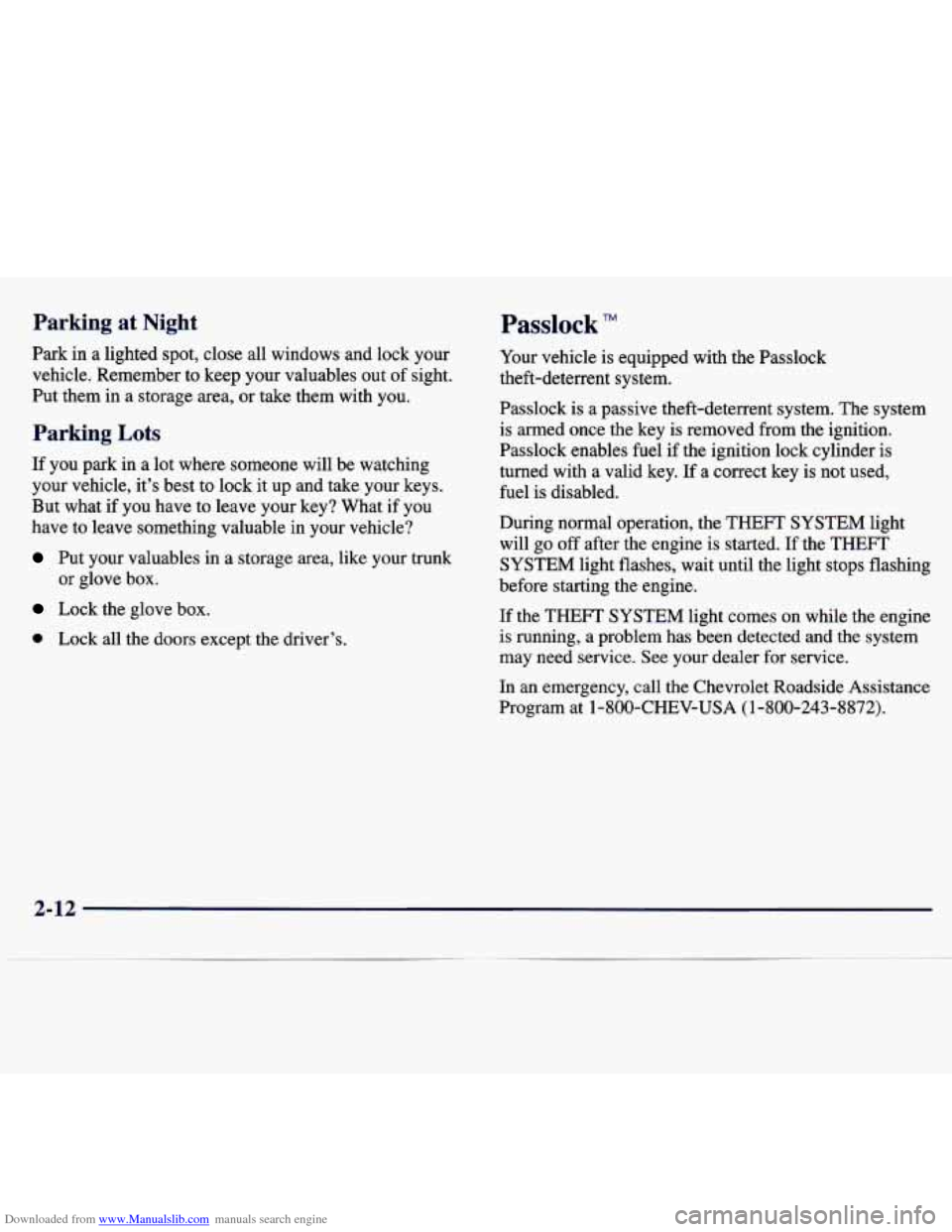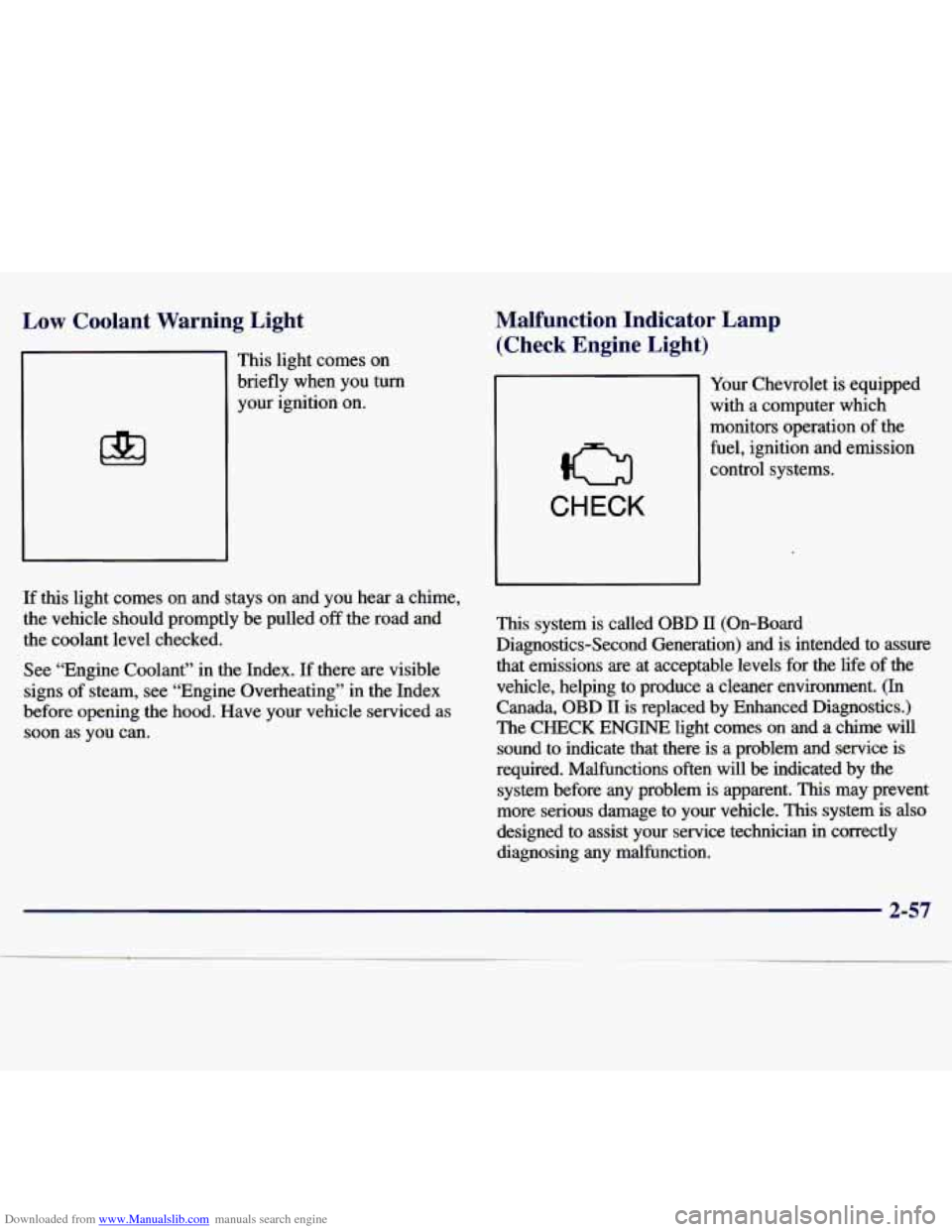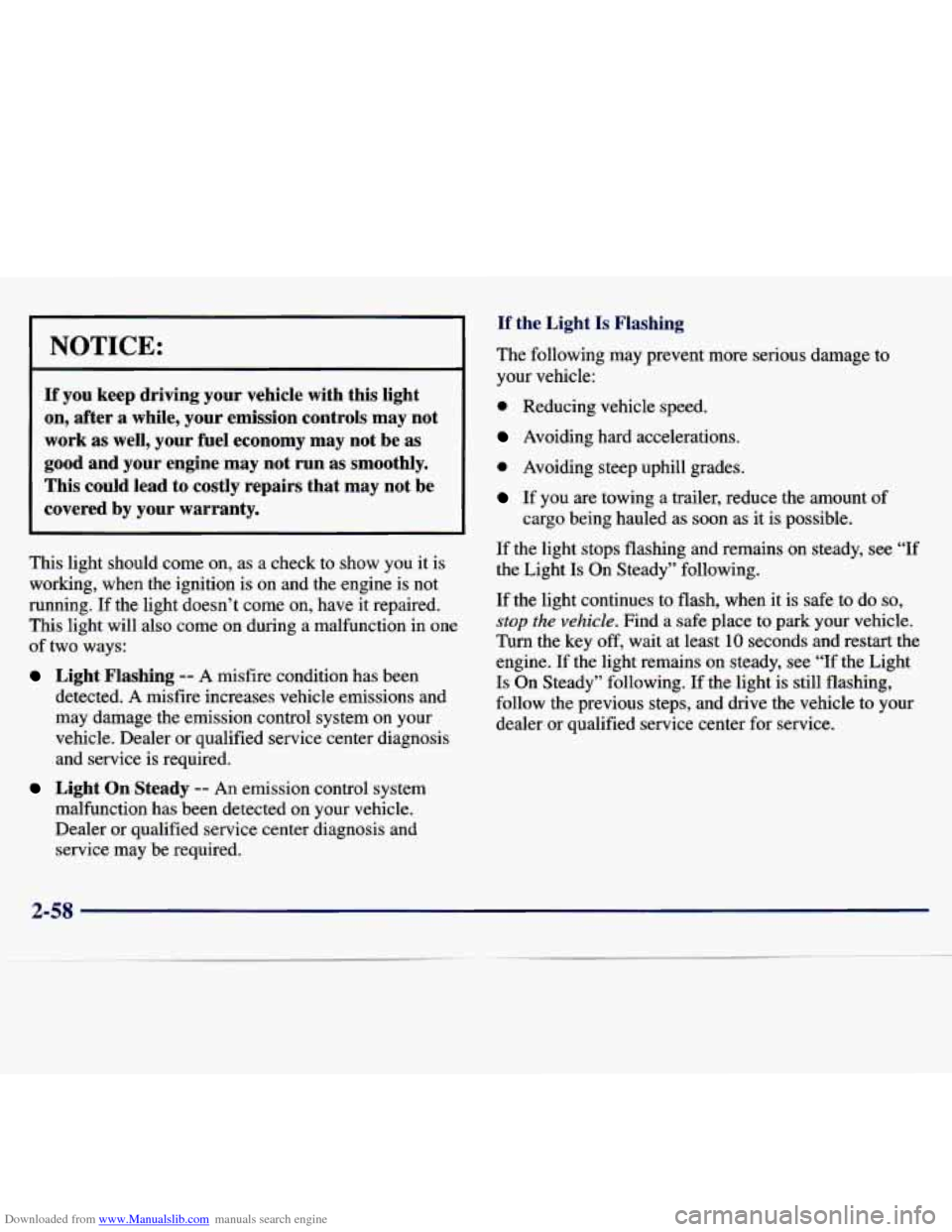Page 6 of 354
Downloaded from www.Manualslib.com manuals search engine I
I The 1957 Chevy started a romance with the American
public
-- and was powered by an available fuel-injected V8.
I I I
I
I
I l
and we are pledged to
make
ownership of your
I I
I
I
I
I
I 1
I
I
I
I
I
I
I
Chevl-olet an enjoyable
and rewarding experience.
60's automotive excitement
included Chevrolet landmarks
like the Corvette Sting Ray,
the sporty Camaro, and
powerplants like the
legendary
327 V8.
Your new Chevrolet continues a tradition of quality and value.
V
Page 9 of 354
Downloaded from www.Manualslib.com manuals search engine 1
Vehicle Symbols
These are some of the symbols you may find on your vehicle.
For example,
these symbols
are used
on an
original battery:
POSSIBLE A
CAUTION
INJURY
PROTECT EYES BY
SHIELDING
Q
CAUSTIC
BURNS
AVO1 D
SPARKS
OR
FLAMES
SPARK
OR ,111,
COULD [-sr=l
FLAME
EXPLODE BAlTERY
...
These symbols
are important
for you and
your passengers
whenever your vehicle
is
driven:
DOOR LOCK
UNLOCK
These symbols
have
to do with
your lamps:
SIGNALS @ e
TURN
FOG LAMPS
$0
These symbols are
on some of
your controls:
WINDSHIELD
WIPER
WINDSHIELD DEFROSTER
WINDOW
DEFOGGER
VENTILATING FAN
These symbols
are used on
warning
and
indicator lights:
ENGINE t
COOLANT kt-
TEMP -
CHARGING I-1
BAlTERY
SYSTEM
BRAKE (@)
COOLANT a
ENGINE OIL e,
PRESSURE
ANTI-LOCK
(a)
BRAKES
Here are some
other symbols
you may see:
FUSE
P
LIGHTER
HORN
)cr
SPEAKER
Er
FUEL B
Page 69 of 354

Downloaded from www.Manualslib.com manuals search engine Parking at Night Passlock TM
Park in a lighted spot, close all windows and lock your
vehicle. Remember to keep your valuables out of sight.
Put them
in a storage area, or take them with you.
Parking Lots
If you park in a lot where someone will be watching
your vehicle, it’s best to lock it up and take your keys. \
But what if you have to leave your key? What if you
have to leave something valuable in your vehicle?
Put your valuables in a storage area, like your trunk
or glove box.
Lock the glove box.
0 Lock all the doors except the driver’s. Your
vehicle is equipped with the Passlock
theft-deterrent system.
Passlock is a passive theft-deterrent system. The system
is armed once the key is removed from the ignition.
Passlock enables fuel
if the ignition lock cylinder is
turned with a valid key. If a correct key is not used,
fuel is disabled.
During normal operation, the THEFT SYSTEM light
will go
off after the engine is started. If the THEFT
SYSTEM light flashes, wait until the light stops flashing
before starting the engine.
If the
THEFT SYSTEM light comes on while the engine
is running, a problem has been detected and the system
may need service. See your dealer for service.
In an emergency, call the Chevrolet Roadside Assistance
Program at 1-800-CHEV-USA
(1-800-243-8872).
2-12
Page 74 of 354
Downloaded from www.Manualslib.com manuals search engine Engine Coolant Heater (If Equipped)
2.4L Engine
3100 Engine
In very cold weather, 0°F (- 18 "C) or colder, the engine
coolant heater can help. You'll get easier starting and
better fuel economy during engine warm-up. Usually,
the coolant heater should be plugged in
a minimum of
four hours prior to starting your vehicle.
2-17
Page 78 of 354

Downloaded from www.Manualslib.com manuals search engine THIRD (3): This position is also used for normal
driving, however, it offers more power and lower fuel
economy than
DRIVE (D). Here are some times you
might choose THIRD
(3) instead of DRIVE (D):
0 When driving on hilly, winding roads.
When towing a trailer, so there is less shifting
between gears.
When going down a steep hill.
SECOND (2): This position gives you more power but
lower fuel economy.
You can use SECOND (2) on hills.
It can help control your speed as you go down steep
mountain roads, but then you would also want to use
your brakes
off and on.
NOTICE:
Don’t drive in SECOND (2) for more than
25 miles (41 km), or at speeds over 55 mph
(88 km/h), or you can damage your transaxle.
Use
DRIVE (D) or THIRD (3) as much as
possible. Don’t shift into SECOND
(2) unless you
are going slower than
65 mph (105 km/h) or you
can damage your engine.
FIRST (1): This position gives you even more power
(but lower fuel economy) than
SECOND (2). You
can use it on very steep hills, or in deep snow or mud.
If the selector lever
is put in FIRST (l), the transaxle
won’t shift into first gear until the vehicle is going
slowly enough.
NOTICE:
If your front wheels can’t rotate, don’t try to
drive. This might happen if you were stuck in
very deep sand or mud
or were up against a solid
object.
You can damage your transaxle.
Also, if you stop when going uphill, don’t hold
your vehicle there with only the accelerator
pedal. This could overheat and damage the
transaxle. Use your brakes or shift into
PARK (P)
to hold your vehicle in position on a hill.
2-21
Page 106 of 354
Downloaded from www.Manualslib.com manuals search engine Your instrument panel is designed to let you know
at a glance how your vehicle is running. You’ll know
how fast you’re going, how much fuel you’re using,
and many other things you’ll need to drive safely
and economically.
The main components of your instrument panel are:
A. Instrument Panel Brightness Control
B. Fog Lamp Switch
C. Turn Signal Multifunction Lever
D. Cruise Control Switches
E. Instrument Cluster
E WIndshield Wipermasher Lever
G. Ignition Switch
H. Hazard Switch
J. Supplemental Restraint System (SRS)
K. Fuse Panel
L. Climate Control System
M. Accessory Power Outlet
N. Ashtray
0. Lighter
P. Audio System
Q. Supplement Restraint System (SRS) and Horn
R. Park Brake Pedal
S. Tilt Wheel Lever
T. Hood Release Lever
U. Remote Trunk Release Switch
V. Instrument Panel Cupholder
2-49
Page 114 of 354

Downloaded from www.Manualslib.com manuals search engine Low Coolant Warning Light
This light comes on
briefly when you turn
If this light comes on and stays on and you hear a chime,
the vehicle should promptly be pulled
off the road and
the coolant level checked.
See “Engine Coolant” in the Index.
If there are visible
signs of steam, see “Engine Overheating”
in the Index
before opening the hood. Have your vehicle serviced as soon as you can.
Malfunction Indicator Lamp
(Check Engine Light)
CHECK
Your Chevrolet is equipped
with a computer which
monitors operation of the
fuel, ignition and emission
control systems.
This system is called OBD 11 (On-Board
Diagnostics-Second Generation) and is intended to assure
that emissions are at acceptable levels for the life of the
vehicle, helping to produce a cleaner environment. (In
Canada, OBD
II is replaced by Enhanced Diagnostics.)
The CHECK ENGINE light comes on and a chime will
sound to indicate that there is a problem and service is
required. Malfunctions often will be indicated by the
system before any problem is apparent.
This may prevent
more serious damage to your vehicle.
This system is also
designed to assist your service technician
in correctly
diagnosing any malfunction.
2-57
Page 115 of 354

Downloaded from www.Manualslib.com manuals search engine NOTICE:
If you keep driving your vehicle with this light
on, after a while, your emission controls may not
work as
well, your fuel economy may not be as
good and your engine may not run as smoothly.
This could lead to costly repairs that may not be
covered by your warranty. If the Light
Is Flashing
The following may prevent more serious damage
to
your vehicle:
0 Reducing vehicle speed.
Avoiding hard accelerations.
0 Avoiding steep uphill grades.
If you are towing a trailer, reduce the amount of cargo being hauled as soon as it is possible.
If the light stops flashing and remains on steady, see “If
the Light
Is On Steady” following.
If the light continues to flash, when it
is safe to do so,
stop the vehick. Find a safe place to park your vehicle.
Turn the key
off, wait at least 10 seconds and restart the
engine. If the light remains on steady, see “If the Light
Is On Steady” following. If the light is still flashing,
follow the previous steps, and drive the vehicle to your dealer or qualified service center for service.
This
light should come on, as a check to show you
it is
working, when the ignition is on and the engine is not
running. If the light doesn’t come on, have it repaired.
This light will
also come on during a malfunction in one
of two ways:
Light Flashing -- A misfire condition has been
detected. A misfire increases vehicle emissions and
may damage the emission control system on your
vehicle. Dealer or qualified service center diagnosis and service is required.
Light On Steady -- An emission control system
malfunction has been detected on your vehicle.
Dealer or qualified service center diagnosis and service may be required.
2-58